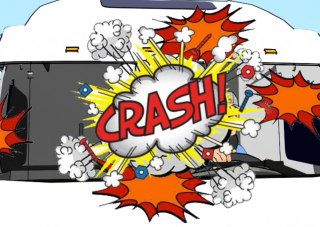Crash Indicator – Level The Playing Field

Crash Indicator
A chance to level the playing field
The government is keeping score. At AccidentPlan.com we have come to the understanding that CSA keeps a constantly running tally of safety performance history on the road. And that includes every motor carrier’s “Crash Indicator”.
Most of us appreciate that there are safety management systems in place. After all, we need to keep the bad actors in check and we should all be held accountable for our actions, right?
But let’s face it. The Crash Indicator BASIC score is fundamentally biased against motor carriers and the hard working drivers they employ.
To review, the Crash Indicator tallies up all of your recordable accidents and compares them in an algorithm against other motor carriers as a percentile rank.
The Crash Indicator, along with scores from the other six BASIC categories is used to assess your safety performance as a motor carrier and potentially identify your company for enforcement and intervention.
Potential clients also use this data during vendor evaluations in order to compare carrier performance.  So it is important to manage this score.
So it is important to manage this score.
The problem is that CSA counts all crash involvement regardless of prevent-ability or fault.
Since we know from research that drivers of large trucks are not at fault in about three quarters of car/truck collisions, your CSA score is very likely getting nicked for actions far beyond your control.
This has been the case since CSA was first implemented several years ago. But finally, after much political wrangling thanks to the American Trucking Association, FMCSA is entertaining a two-year pilot program by which motor carriers can now submit information for review and petition to have non-preventable crashes removed from their Crash Indicator scores.
have non-preventable crashes removed from their Crash Indicator scores.
It’s a good start, but the proposal does not go nearly far enough toward an equitable solution.
First of all, CSA is suggesting very narrow criteria to prove a non-preventable crash.
In order to pass review a motor carrier must prove that a motorist who was convicted of either DUI or wrong way driving struck the CMV. They will also consider a rear end collision or collision when your truck was legally stopped.
That’s it. No more.
The ATA is working on getting animal strikes and suicide-by-truck crashes added to the list as well and we should lend them our support. I will explain how in a moment.
But even if they are successful, they are still missing many types of non-preventable crashes like the car taking a U-turn from the right lane directly across your path.
Furthermore, as yet the agency will only recognize documentation of preventability in the form of police accident reports (PARs) or insurance reports; both of which hold bias.
They do not yet recognize information generated by the motor carrier such as driver crash reports or dash cam video.
 But here is the good news. And here is how we can do our part to level the playing field.
But here is the good news. And here is how we can do our part to level the playing field.
Before the demonstration period is to take place, Federal Motor Carrier Safety is actively seeking open commentary from industry stakeholders.
The comment period opened on July 12 and will close at midnight on September 12 and they are especially interested in comments regarding what other documentation would be sufficient to make a determination of non-preventable crash.
We deserve the opportunity to protect our safety reputations and to speak in our own defense. In a court of law one is presumed innocent until proven guilty. At the FMCSA the burden of proof is decidedly slanted the other way.
As motor carriers we are regularly and unfairly presumed guilty. Therefore we need every opportunity to demonstrate that we are good stewards of highway safety.
In the coming weeks we will be addressing this issue in depth and carefully composing our arguments for allowing motor carriers to submit for review crash data collected at the scene by the driver or third party investigator.
We invite you to do the same and submit your comments to the FMCSA.
But we want to hear from you too. Please comment below and tell us your thoughts about Crash Accountability and what it means for your operation.
We plan to carefully review and compile comments from our readers and followers into a single, articulate and well-formed argument to allow motor carriers to submit their own data for review and to broaden the scope of the Crash Accountability criteria.
We will follow the process through the comment and testing period and will bring you updates as they become available.
It’s our voice. Let’s use it.

